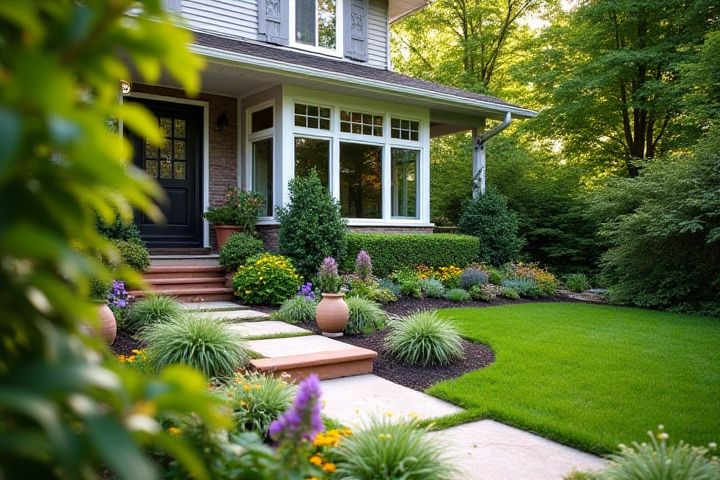
In landscaping your backyard, start by assessing the space and its sunlight exposure, which influences plant growth. Create distinct zones for various activities such as relaxation, gardening, or play, utilizing paths made from gravel or pavers for easy navigation. Select native plants that require minimal maintenance while enhancing biodiversity, focusing on seasonal blooms for year-round interest. Incorporate features like a fire pit or seating area to foster a welcoming atmosphere for gatherings with family and friends. To maintain sustainability, consider implementing rain gardens or xeriscaping techniques to optimize water usage and reduce upkeep efforts.
How To Landscape A House Backyard
Assess the terrain and climate
Assessing your backyard's terrain and climate is crucial for effective landscaping. Start by evaluating the slope, soil type, and drainage of your property; a well-drained area is ideal for planting and prevents water accumulation. Consider local climate conditions, including temperature ranges, rainfall patterns, and frost dates, as they dictate plant selection and maintenance requirements. By understanding these factors, you can choose suitable native plants and materials that thrive and enhance your backyard's aesthetic appeal while ensuring sustainability.
Create a functional layout
To create a functional layout for your backyard, start by assessing the available space, measuring your area in square feet to determine optimal usage. Consider incorporating key zones: a recreational area for activities, a dining space for entertaining, and landscaped gardens for aesthetics. Use pathways, such as gravel or pavers, to connect these zones while maintaining accessibility and flow. Lastly, ensure you account for sunlight patterns, as allocating about 6 hours of sunlight per day for your garden beds will enhance plant growth and create a vibrant outdoor environment.
Choose appropriate plants
Choosing appropriate plants for your backyard is crucial for creating a thriving landscape. Consider native species that require less water and maintenance, which can grow well in your local climate; for example, using drought-resistant plants can reduce irrigation needs by up to 50%. Incorporate a mix of perennials, shrubs, and ornamental grasses to provide year-round color and texture, and aim for a ratio of at least 60% native plants in your design for ecological benefits. Don't forget to evaluate the sunlight, soil type, and the size of the area, as these factors can significantly influence plant health and growth.
Consider irrigation needs
When landscaping your backyard, prioritizing irrigation systems is crucial for maintaining plant health and conserving water. Consider implementing a drip irrigation system, which minimizes evaporation and directs water to the roots, ensuring efficient water usage. The average garden requires around 1 to 1.5 inches of water per week, so calculating the appropriate coverage area will help you plan your layout effectively. Incorporating drought-resistant plants can also reduce water needs, giving your landscaped space sustainability while enhancing aesthetic appeal.
Plan for outdoor lighting
Planning outdoor lighting for your backyard involves strategically placing fixtures to enhance both functionality and aesthetics. Consider incorporating path lights along walkways, spotlighting architectural features or trees, and installing ambient lighting for seating areas, ensuring a warm and inviting atmosphere. Solar-powered lights can be an eco-friendly option, while LED fixtures provide energy efficiency and longevity. Remember to choose fixtures that complement your home's design and to create layers of light, balancing brightness and softness for a well-lit yet cozy environment.
Integrate hardscape elements
Integrating hardscape elements in your backyard can enhance functionality and aesthetic appeal. Consider installing a patio or deck that comprises durable materials like stone or composite wood, which can cover up to 25% of your outdoor space. Incorporating walkways made from pavers or gravel not only facilitates movement but also contributes to effective drainage, reducing soil erosion by up to 30%. Don't forget to add features like retaining walls or raised garden beds, which can create defined areas and elevate the overall design of your backyard landscape.
Incorporate privacy features
Incorporate privacy features in your backyard by strategically planting dense evergreen trees or tall shrubs, which can create a natural barrier against noise and prying eyes. Installing a decorative fence or lattice can enhance your outdoor space while providing a sense of security; consider materials like wood or vinyl to match your home's aesthetic. Adding outdoor curtains or trellises with climbing vines offers not only seclusion but also visual interest to your surroundings. Finally, consider using outdoor privacy screens--ranging from 6 to 8 feet high--for a flexible solution that can adjust to your landscaping needs.
Focus on sustainable practices
Transforming your backyard into a sustainable landscape involves a mix of native plants, efficient water management, and eco-friendly materials. Choosing native plants requires less maintenance and encourages local wildlife, reducing the need for fertilizers and pesticides. Implementing a rain garden or permeable paving can help manage stormwater runoff effectively, promoting groundwater recharge while minimizing erosion. Consider incorporating organic compost to enrich your soil while practicing techniques such as mulching and crop rotation for continuous growth without synthetic additives.
Allow for seasonal changes
When landscaping your backyard, consider incorporating a variety of plants that bloom in different seasons, such as tulips for spring, sunflowers for summer, and chrysanthemums for fall. Choose hardwood trees like oaks or maples to provide shade and display vibrant colors during autumn. Implement hardscape features, such as stone pathways or wooden decks, which remain functional year-round regardless of weather changes. Incorporating evergreens will ensure your landscape retains visual interest even in winter, creating a dynamic and captivating outdoor space throughout the year.
Set a realistic budget
Setting a realistic budget for landscaping your backyard involves assessing both your financial limits and the value you expect from the project. You might start by researching the average costs, which can range from $5 to $15 per square foot, depending on the complexity of the design and the materials chosen. Allocate funds for major elements such as plants, soil, hardscaping, and labor, ensuring to leave a 10-20% buffer for unexpected expenses. Prioritize your spending on features that will enhance your outdoor space most effectively, such as native plants that require less maintenance and irrigation.
